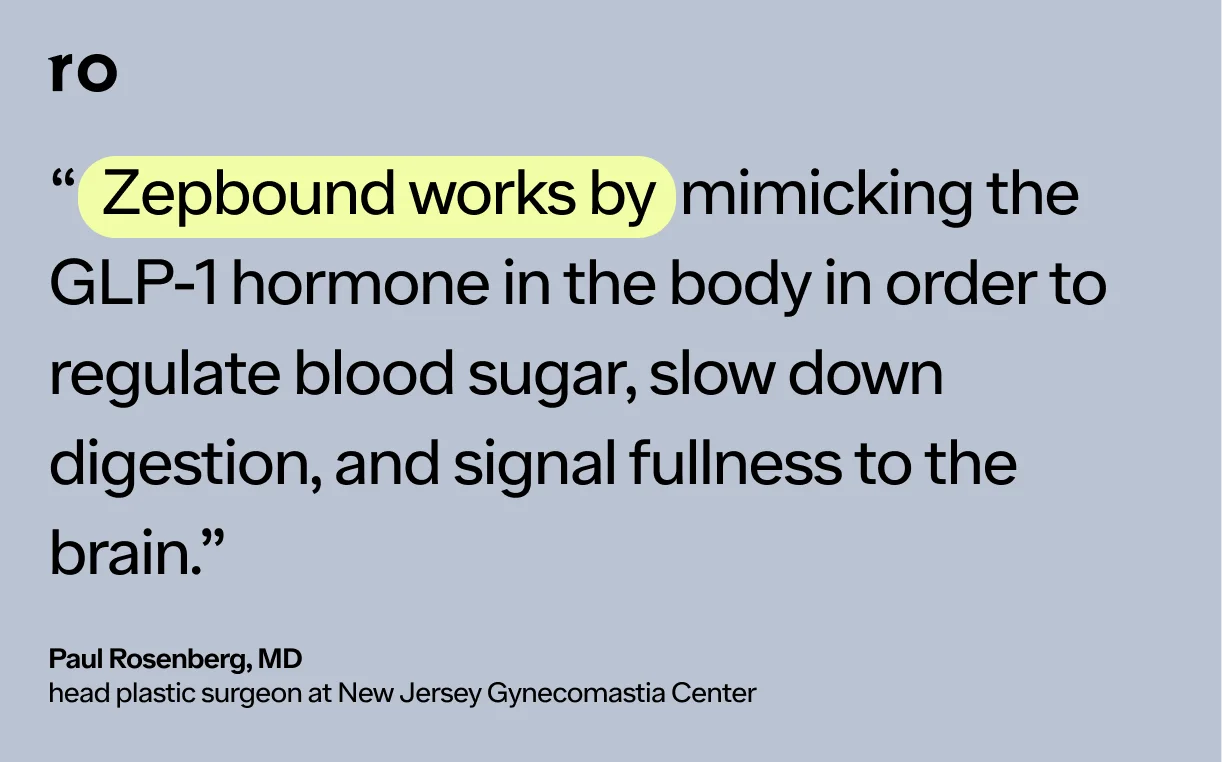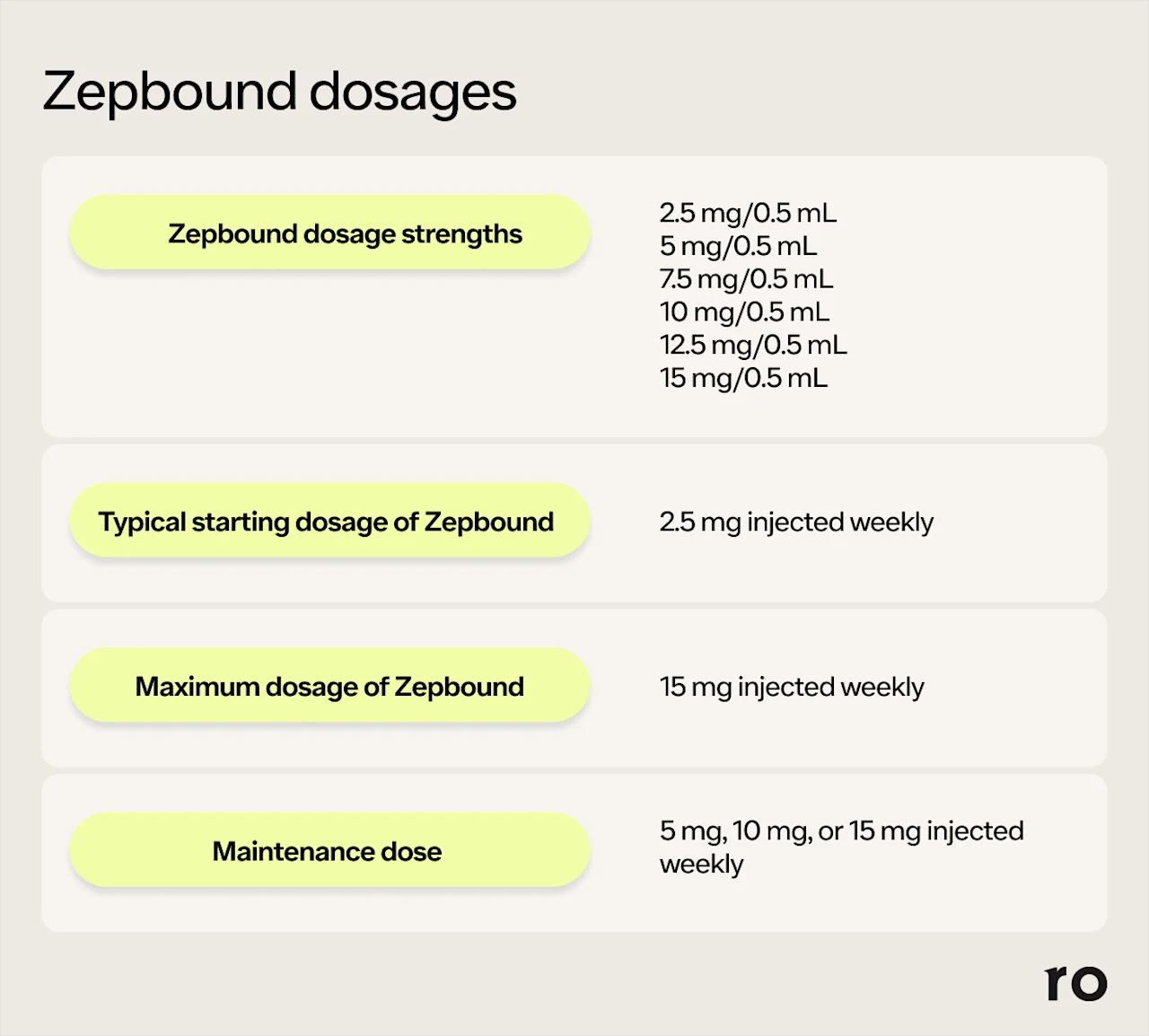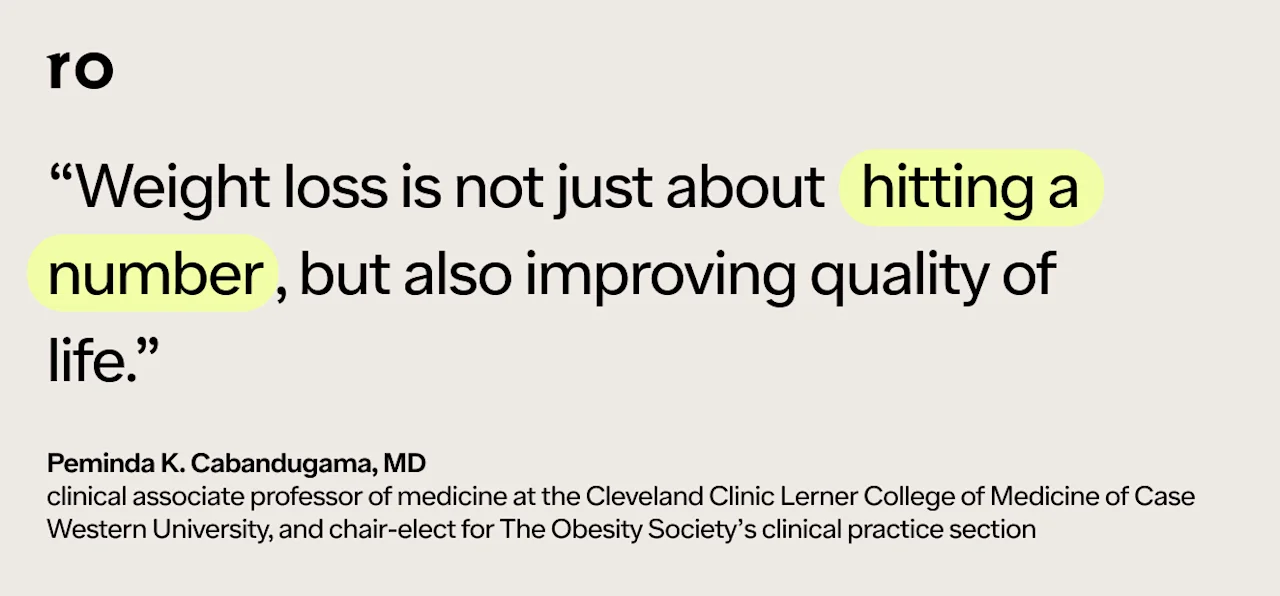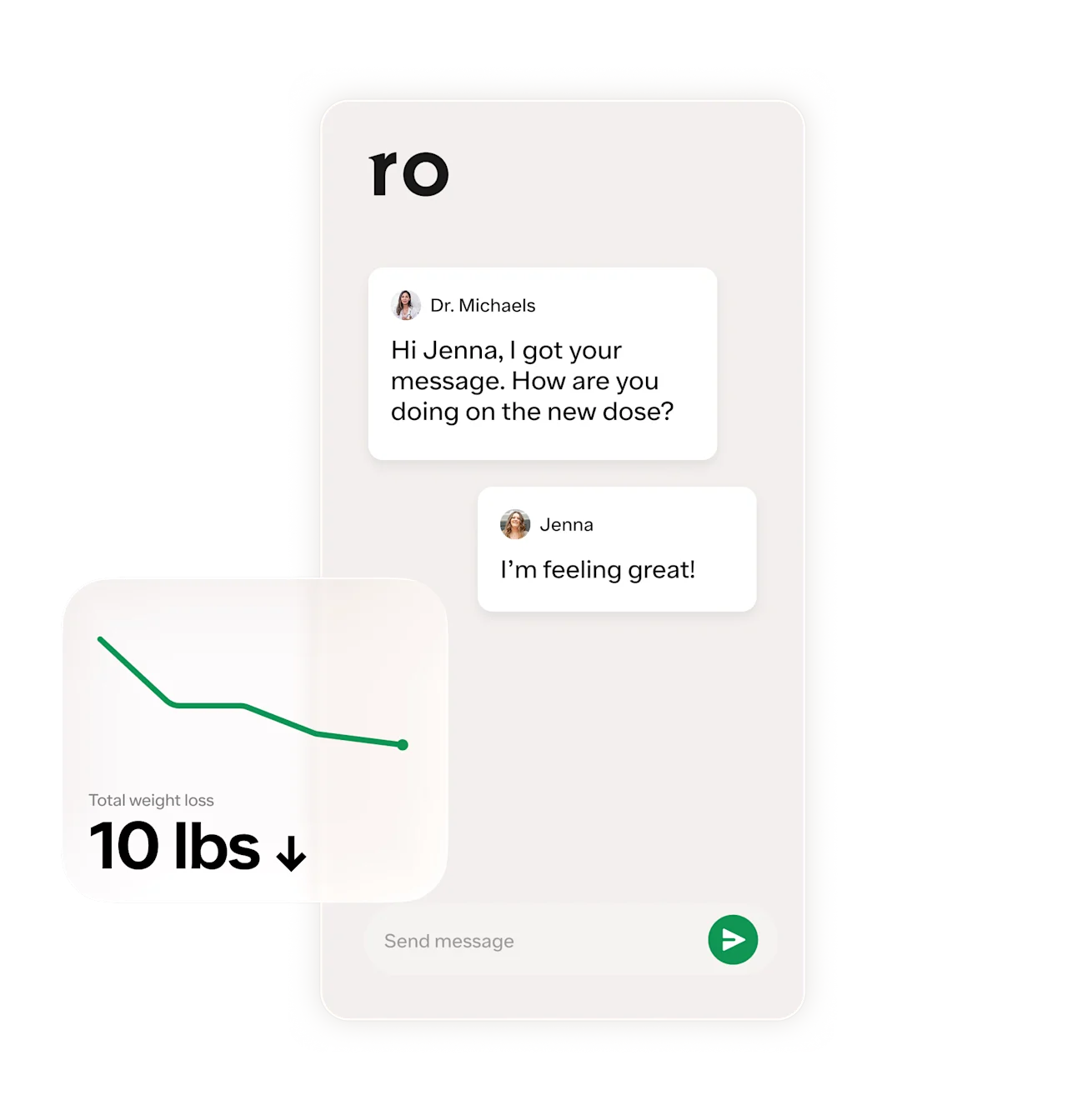Key takeaways
Zepbound works by mimicking the natural gut hormones GLP-1 and GIP to regulate appetite, slow digestion, and quiet food noise, promoting weight loss.
Unlike other GLP-1 medications like Wegovy or Ozempic, Zepbound targets two hormone receptors, amplifying its effects on food cravings, appetite regulation, and weight loss.
In clinical trials, people taking Zepbound have lost up to 20.9% of their body weight in about a year and a half, depending on the dose.
Zepbound comes in a single dose pen or in a vial for half of the price of the pen, which you can get directly from Ro if you qualify.
Here's what we'll cover
Key takeaways
Zepbound works by mimicking the natural gut hormones GLP-1 and GIP to regulate appetite, slow digestion, and quiet food noise, promoting weight loss.
Unlike other GLP-1 medications like Wegovy or Ozempic, Zepbound targets two hormone receptors, amplifying its effects on food cravings, appetite regulation, and weight loss.
In clinical trials, people taking Zepbound have lost up to 20.9% of their body weight in about a year and a half, depending on the dose.
Zepbound comes in a single dose pen or in a vial for half of the price of the pen, which you can get directly from Ro if you qualify.
Zepbound (tirzepatide) is a once-weekly injectable prescription medication that can lead to an average weight loss of up to 20.9% in 72 weeks. The weight loss drug was approved by the US Food & Drug Administration (FDA) in 2023, and has been making headlines ever since, most recently as the first medication approved for sleep apnea at the end of 2024. But how does Zepbound work, exactly?
Read on as we answer that question and more, including who is Zepbound right for, how long do you have to take it, and what side effects you can expect.
How does Zepbound work?
“Zepbound works by mimicking the GLP-1 hormone in the body in order to regulate blood sugar, slow down digestion, and signal fullness to the brain. This helps to reduce appetite and make you feel full for longer after eating, which in turn supports weight loss,” says Paul Rosenberg, MD, a board-certified plastic surgeon who runs the New Jersey Gynecomastia Center, where he often treats patients for weight loss with GLP-1s prior to performing surgery. “It also improves insulin sensitivity, making it beneficial for people with insulin resistance or prediabetes.”
Zepbound is part of a larger category of drugs called GLP-1 receptor agonists, which treat obesity and overweight, type 2 diabetes, and cardiovascular disease (in conjunction with obesity or type 2 diabetes). GLP-1 stands for glucagon-like peptide-1, which is a gut hormone these drugs mimic.
But Zepbound—and its sister medication, Mounjaro, which contains the same active ingredient (tirzepatide)--is unique among GLP-1 drugs. That’s because Zepbound is not just a GLP-1 receptor agonist, but a dual GIP/GLP-1 receptor agonist. Unlike Wegovy (semaglutide), Saxenda (liraglutide), and other GLP-1 drugs, Zepbound targets two receptors in the body, instead of just one. It works on both GLP-1 as well as GIP, which is short for glucose-dependent insulinotropic polypeptide. This may help explain why tirzepatide is more effective at both weight loss and blood sugar control than placebo when compared to the effects of single-receptor GLP-1s like Wegovy, Ozempic, or Saxenda versus placebo.
Both GIP and GLP-1 are gut hormones your body naturally produces. After you eat, these hormones direct your pancreas to release more insulin and tell your liver to slow down glucose production. This helps balance blood sugar levels. At the same time, these hormones slow down how quickly food moves through your stomach into the small intestine (a process known as gastric emptying) and send signals to your brain telling it you’re full.
And, research shows their role in appetite regulation may go even further—by reducing cravings and quieting “food noise” (e.g. frequent, intrusive thoughts about food, such as when and what you’ll eat next).
So, as a recap, Zepbound works for weight loss by:
Keeping food in your stomach longer, so you feel full sooner and longer
Sending satiety signals to your brain that regulate your appetite, so you feel less hungry and consume fewer calories
Quieting “food noise,” so you feel less focused on food
Managing your insulin and glucose levels, so you avoid sugar spikes and crashes

How well does Zepbound work for weight loss?
Drugs like Zepbound treat weight loss from multiple angles, which is why you’ll often see them referred to as “second generation” weight loss medications, says Peminda K. Cabandugama, MD, a board-certified endocrinologist, Clinical Associate Professor of Medicine at the Cleveland Clinic Lerner College of Medicine of Case Western University, and Chair-Elect for The Obesity Society’s Clinical Practice Section. “These drugs work in two different ways to reduce how much we eat vs. earlier generation medications, which either cut down cravings or reduced food intake.”
That multi-factored approach leads to impressive weight loss results, according to a 72-week clinical trial of people with obesity or overweight. Those who took Zepbound lost between 15-20.9% of their body weight, while the placebo group lost 3.1%. An extra analysis of the data from this study found that more than one-third of participants on the highest 15-milligram dose of Zepbound lost at least 25% of their body weight. Note that this finding may be less reliable since it wasn’t the main focus of the research, but still supports Zepbound’s role as a powerful tool for weight loss.
In addition to the medication, participants also received counseling sessions to improve their diets (while eating 500 fewer calories a day) and increase their physical activity to at least 150 minutes weekly. Zepbound is meant to be used in combination with diet and exercise.
How long does Zepbound stay in your system?
Zepbound has a half-life of 5 days. A drug’s half-life describes the length of time it takes to remove half of it from your body. Thanks to Zepbound’s multi-day half-life, you only have to inject the medication once a week.
However, because Zepbound has a decently long half-life, it also takes longer for it to flush out of your body fully. Once you stop taking Zepbound, it takes about 30 days for it to be completely gone, according to Eli Lilly, the maker of Zepbound.
How long does it take for Zepbound to start working?
Zepbound starts working once you take it, but it will take about four weeks to reach a steady concentration in your bloodstream. People typically start to notice weight loss at this point, too, with those in clinical trials experiencing around 4% weight loss within the first month of taking Zepbound. The majority of weight loss occurs in the first nine months of taking Zepbound, although people may continue to lose weight if they keep taking the medication.
While some weight loss can occur in the first four weeks of taking Zepbound, it typically takes longer for you to experience the full effects of the medication. In part, this is due to the drug’s gradual dosing schedule.
Zepbound, along with other GLP-1 medications, follows a titration schedule, where you gradually increase your dosage of the medication over a period of weeks to months until you find a dose that’s effective and tolerable for you (e.g. you experience the therapeutic benefits and can manage the side effects). Once you reach that dose, you’ll stay at that dose. This is called your maintenance dose, and for Zepbound it’s either 5 mg, 10 mg, or 15 mg weekly.
Here is an overview of Zepbound dosages:

Who is Zepbound right for?
Zepbound is FDA-approved for weight loss and weight management in adults with:
Overweight with a weight-related comorbidity such as type 2 diabetes, high blood pressure, high cholesterol, heart disease, or sleep apnea
In addition, as of December 20, 2024, the FDA approved Zepbound for a second purpose: to treat obstructive sleep apnea in adults with obesity.
“A good candidate for Zepbound is typically an adult with a BMI of 30+ or someone with a BMI of 27+ who also has weight-related health issues like high blood pressure, type 2 diabetes, or sleep apnea,” says Dr. Rosenberg. “Good candidates are also those who are ready to commit to lifestyle changes, like a nutrient-rich, balanced diet and regular exercise, as Zepbound is most effective when used in combination with these healthy lifestyle changes.”
“Weight loss is not just about hitting a number, but also improving quality of life,” says Dr. Cabandugama. “Everyone [who is a candidate for Zepbound] has the same comorbidity, which is the reduced quality of life you have with obesity.”

Who should avoid Zepbound?
Like most prescription drugs, Zepbound is not safe for everyone, and some people should not take it. “Anyone who has had, or has a family history of medullary thyroid cancer or multiple endocrine neoplasia syndrome type 2 is advised against taking Zepbound,” says Dr. Rosenberg. “If you react poorly to or have a known hypersensitivity to GLP-1 receptor agonists, you would also not be a good candidate for Zepbound or any other GLP-1 receptor agonists.”
Besides these contraindications, some people may be more likely to experience serious side effects on Zepbound, including those with:
Severe gastrointestinal disease
Kidney or gallbladder problems
A history of diabetic retinopathy (a vision-related complication of type 2 diabetes)
People who are pregnant, trying to get pregnant, or planning to have surgery soon should tell their healthcare provider before starting Zepbound. Zepbound can also interact with insulin, insulin secretagogues, and oral contraceptives (i.e. birth control pills), so it’s important to share a full list of any medications you are taking with your doctor prior to starting Zepbound. They can advise you on how to adjust your dosage of these other medications or recommend another weight loss medication altogether.
Does Zepbound cause side effects?
“The most common side effects of Zepbound are nausea, vomiting, diarrhea, constipation, and GI discomfort,” says Dr. Rosenberg. “These side effects typically improve as your body adjusts to the medication.”
Here’s a list of the most common Zepbound side effects reported in clinical trials for weight loss:
Zepbound side effect | Percent of users who reported it in clinical trials |
|---|---|
Nausea | 25–29% |
Diarrhea | 19–23% |
Vomiting | 8–13% |
Constipation | 11–17% |
Abdominal pain | 9–10% |
Upset stomach or indigestion | 9–10% |
Injection site reactions (e.g. rash, itching, bruising, pain) | 6–8% |
Fatigue | 5–7% |
Mild allergic reactions | 5% |
Belching | 4–5% |
Hair loss | 4–5% |
Heartburn | 4–5% |
Dizziness | 4–5% |
Flatulence | 3–4% |
Bloating | 3–4% |
Hypotension (low cholesterol) | 1–2% |
While rare, Zepbound can cause serious side effects. These include:
Severe gastrointestinal reactions
Acute kidney injury
Acute gallbladder disease
Acute pancreatitis
Serious allergic reactions
Hypoglycemia (low blood pressure)
Diabetic retinopathy complications
Depression and suicidal behavior or ideation
Pulmonary aspiration during general anesthesia or deep sedation
How to manage Zepbound side effects
Zepbound does have a long list of potential side effects, but the good news is that the most common ones like nausea and vomiting tend to lessen with time as your body gets used to the medication. If you’re experiencing gastrointestinal side effects on Zepbound, there are things you can do to manage them.
“To manage side effects, it helps to eat smaller, more frequent meals and avoid large, high-fat, or greasy meals,” Dr. Rosenberg says. “Staying hydrated and eating bland, low-acid foods like crackers, rice, or bananas can also reduce nausea. If side effects persist or worsen, patients should talk with their healthcare provider about adjusting the dosage or the timing of the doses. If the side effects are really severe and can’t be tolerated, patients probably want to explore other more sustainable weight loss options.”
Other tips for managing Zepbound side effects include:
Avoiding alcohol and carbonated beverages
Eating slowly and stopping once you feel full
Not lying down after you eat
Ensuring you’re getting enough fiber in your diet
Increasing your physical activity
Asking your healthcare provider about anti-nausea medication, stool softeners, or probiotics
How long do you have to take Zepbound?
“Most people continue to take Zepbound as long as it’s effective and they can tolerate the side effects,” says Dr. Rosenberg. “If you stop taking Zepbound without incorporating significant lifestyle changes, appetite and weight gain often return.”
In one study of Zepbound, participants took the two highest maintenance doses for 36 weeks and lost 20.9% of their body weight, on average. Then, some participants were switched to a placebo while others kept taking Zepbound. Over the next year, those who switched to a placebo gained back 14% of their body weight, while those taking Zepbound continued to lose an additional 5.5%.
“Weight is a set point,” says Dr. Cabandugama. “What we are doing [with these medications] is bringing that set point down. The weight can still go back up. The mindset we want people to think about with obesity is a chronic disease. If you have high blood pressure and your blood pressure is controlled, you don’t stop your medication, you keep taking it to keep it under control. If you think of obesity as a chronic disease, it’s the same thing: you want to manage it.”
Bottom line: how Zepbound works
Zepbound works by mimicking two gut hormones that slow down gastric emptying, tell the brain you’re full, and manage blood sugar levels.
The active ingredient in Zepbound, tirzepatide, is unique among GLP-1 medications in that it targets both GLP-1 and GIP receptors. This makes it more effective at reducing appetite, controlling blood sugar, and managing body weight compared to single-receptor GLP-1 drugs like Wegovy and Saxenda.
Zepbound starts working as soon as you take it, but it can take about a month before you notice weight loss. By that point, people in clinical trials lost about 4% of their body weight.
Zepbound may cause a number of side effects, many of which are digestive in nature and go away as your body gets used to the medication. with your full medical history and a list of any medications you are taking.
While Zepbound produces significant weight loss, it works best when combined with a healthy diet and regular physical activity. Stopping Zepbound may lead to weight regain, especially if these lifestyle changes aren’t continued.
Frequently asked questions (FAQs)
How much weight will I lose in a month on Zepbound?
In one month, people taking Zepbound lost around 4% of their body weight in clinical trials, on average. How much weight you lose on Zepbound can vary from person to person and depends on several factors, including your dosage, your initial body weight, and the other lifestyle changes you are making, such as diet and exercise.
Is Zepbound bad for the kidneys?
While rare, Zepbound can cause serious side effects, including kidney failure. Some of Zepbound’s more common side effects—including nausea, vomiting, and diarrhea—can lead to dehydration which, if you’re not replenishing your fluids, can be serious enough to cause kidney problems. In clinical trials, 0.5% of people taking Zepbound experienced acute kidney injury, compared to 0.2% of those taking a placebo.
Is Zepbound better than Ozempic?
The question of whether Zepbound vs. Ozempic will be better for you is a decision only you and your healthcare provider can make together, as it can depend on various factors ranging from your personal health situation to your insurance coverage. However, in a comparison analysis people who took tirzepatide lost significantly more weight over the course of a year than people who took Ozempic (semaglutide). Tirzepatide users were more than twice as likely to lose at least 10% of their body weight, and more than three times as likely to lose 15% of their body weight, when compared to those taking Ozempic.
It’s worth noting that Zepbound and Ozempic are FDA-approved for different indications. Zepbound is FDA-approved for weight loss and weight maintenance as well as sleep apnea, while Ozempic is FDA-approved to control blood sugar levels and reduce cardiovascular risk in people with type 2 diabetes. Because it produces weight loss, healthcare providers may prescribe Ozempic for weight loss, but this is considered an off-label use of the medication.
Why am I losing weight slowly on Zepbound?
If you’re not losing weight as quickly as you expected to, talk to your healthcare provider. Your weight loss may actually be typical, or there could be lifestyle changes you need to make while you take Zepbound. Around 0.5–2 pounds per week is considered a healthy rate of weight loss.
If you want to lose weight more quickly on Zepbound, start by reviewing your diet and exercise routine. Eating fewer calories than you burn is one of the most efficient ways to lose weight. Pairing a reduced-calorie diet with exercise—as is recommended when taking Zepbound—ensures you keep the weight off and maintain or build more muscle, which can further aid in weight loss.
Also, some people simply lose weight more slowly on tirzepatide (the active ingredient in Mounjaro and Zepbound), including those with type 2 diabetes. For example, in one 72-week study, people with type 2 diabetes lost 12.8–14.7% of their body weight on the two highest doses of tirzepatide. In another clinical trial that also lasted 72 weeks, people with obesity or overweight (but without type 2 diabetes) taking the same doses of tirzepatide lost 19.5–20.9% of their body weight.
DISCLAIMER
If you have any medical questions or concerns, please talk to your healthcare provider. The articles on Health Guide are underpinned by peer-reviewed research and information drawn from medical societies and governmental agencies. However, they are not a substitute for professional medical advice, diagnosis, or treatment.
Zepbound Important Safety Information: Read more about serious warnings and safety info.
Mounjaro Important Safety Information: Read more about serious warnings and safety info.
GLP-1 Important Safety Information: Read more about serious warnings and safety info.
Wegovy Important Safety Information: Read more about serious warnings and safety info.
Saxenda Important Safety Information: Read more about serious warnings and safety info.
Ozempic Important Safety Information: Read more about serious warnings and safety info.
References
Aronne, L. J., Sattar, N., Horn, D. B., et al. (2024). Continued Treatment With Tirzepatide for Maintenance of Weight Reduction in Adults With Obesity: The SURMOUNT-4 Randomized Clinical Trial. JAMA, 331(1), 38–48. doi: 10.1001/jama.2023.24945. Retrieved from https://pmc.ncbi.nlm.nih.gov/articles/PMC10714284/
Cai, W., Zhang, R., Yao, Y., et al. (2024). Tirzepatide as a novel effective and safe strategy for treating obesity: a systematic review and meta-analysis of randomized controlled trials. Frontiers in Public Health, 12, 1277113. doi: 10.3389/fpubh.2024.1277113. Retrieved from https://pmc.ncbi.nlm.nih.gov/articles/PMC10864442/
Eli Lilly. (2023). How long will Zepbound (tirzepatide) be in the body after the last dose?. Retrieved from https://medical.lilly.com/us/products/answers/how-long-will-zepbound-tirzepatide-be-in-the-body-after-the-last-dose-209518
Farzam, K. & Patel, P. (2024). Tirzepatide. StatPearls. Retrieved from https://www.ncbi.nlm.nih.gov/books/NBK585056/
Garvey, W. T., Frias, J. P., Jastreboff, A. M., et al. (2023). Tirzepatide once weekly for the treatment of obesity in people with type 2 diabetes (SURMOUNT-2): a double-blind, randomised, multicentre, placebo-controlled, phase 3 trial. Lancet (London, England), 402(10402), 613–626. doi: 10.1016/S0140-6736(23)01200-X. Retrieved from https://pubmed.ncbi.nlm.nih.gov/37385275/
Gorgojo-Martínez, J. J., Mezquita-Raya, P., Carretero-Gómez, J., et al. (2022). Clinical Recommendations to Manage Gastrointestinal Adverse Events in Patients Treated with Glp-1 Receptor Agonists: A Multidisciplinary Expert Consensus. Journal of Clinical Medicine, 12(1), 145. doi: 10.3390/jcm12010145. Retrieved from https://pmc.ncbi.nlm.nih.gov/articles/PMC9821052/
Hayashi, D., Edwards, C., Emond, J. A., et al. (2023). What Is Food Noise? A Conceptual Model of Food Cue Reactivity. Nutrients, 15(22), 4809. doi: 10.3390/nu15224809. Retrieved from https://pmc.ncbi.nlm.nih.gov/articles/PMC10674813/
Heise, T., DeVries, J. H., Urva, S., et al. (2023). Tirzepatide Reduces Appetite, Energy Intake, and Fat Mass in People With Type 2 Diabetes. Diabetes Care, 46(5), 998–1004. doi: 10.2337/dc22-1710. Retrieved from https://pmc.ncbi.nlm.nih.gov/articles/PMC10154650/
Jastreboff, A. M., Aronne, L. J., Ahmad, N. N., et al. (2022). Tirzepatide Once Weekly for the Treatment of Obesity. The New England Journal of Medicine, 387(3), 205–216. doi: 10.1056/NEJMoa2206038. Retrieved from https://www.nejm.org/doi/10.1056/NEJMoa2206038
Lee, S. & Lee, D. Y. (2017). Glucagon-like peptide-1 and glucagon-like peptide-1 receptor agonists in the treatment of type 2 diabetes. Annals of Pediatric Endocrinology & Metabolism, 22(1), 15–26. doi: 10.6065/apem.2017.22.1.15. Retrieved from https://pmc.ncbi.nlm.nih.gov/articles/PMC5401818/
Lin, F., Yu, B., Ling, B., et al. (2023). Weight loss efficiency and safety of tirzepatide: A Systematic review. PloS One, 18(5), e0285197. doi: 10.1371/journal.pone.0285197. Retrieved from https://pmc.ncbi.nlm.nih.gov/articles/PMC10159347/
Maselli, D. B. & Camilleri, M. (2021). Effects of GLP-1 and Its Analogs on Gastric Physiology in Diabetes Mellitus and Obesity. Advances in Experimental Medicine and Biology, 1307, 171–192. doi: 10.1007/5584_2020_496. Retrieved from https://pubmed.ncbi.nlm.nih.gov/32077010/
Rodriguez, P. J., Goodwin Cartwright, B. M., Gratzl, S., et al. (2024). Semaglutide vs Tirzepatide for Weight Loss in Adults With Overweight or Obesity. JAMA Internal Medicine, 184(9), 1056–1064. doi: 10.1001/jamainternmed.2024.2525. Retrieved from https://pmc.ncbi.nlm.nih.gov/articles/PMC11231910/
Samms, R. J., Coghlan, M. P., & Sloop, K. W. (2020). How May GIP Enhance the Therapeutic Efficacy of GLP-1?. Trends in Endocrinology and Metabolism: TEM, 31(6), 410–421. doi: 10.1016/j.tem.2020.02.006. Retrieved from https://www.cell.com/trends/endocrinology-metabolism/fulltext/S1043-2760(20)30048-5
Schwartz, J. (2016). Nutritional Therapy. Primary Care, 43(1), 69–81, viii. doi: 10.1016/j.pop.2015.08.012. Retrieved from https://pubmed.ncbi.nlm.nih.gov/26896201/
U.S. Food & Drug Administration (FDA). (2023). FDA Approves New Medication for Chronic Weight Management. Retrieved from https://www.fda.gov/news-events/press-announcements/fda-approves-new-medication-chronic-weight-management
U.S. Food & Drug Administration (FDA-a). (2024). Highlights of Prescribing Information: Ozempic (semaglutide injection, for subcutaneous use. Retrieved from https://www.accessdata.fda.gov/drugsatfda_docs/label/2024/209637s032lbl.pdf
U.S. Food & Drug Administration (FDA-b). (2024). Highlights of Prescribing Information: Zepbound (tirzepatide injection, for subcutaneous use. Retrieved from https://www.accessdata.fda.gov/drugsatfda_docs/label/2024/217806s005s006s011s015s019lbl.pdf
Wadden-a, T. A., Chao, A. M., Moore, M., et al. (2023). The Role of Lifestyle Modification with Second-Generation Anti-obesity Medications: Comparisons, Questions, and Clinical Opportunities. Current Obesity Reports, 12(4), 453–473. doi: 10.1007/s13679-023-00534-z. Retrieved from https://pmc.ncbi.nlm.nih.gov/articles/PMC10748770/
Wadden-b, T. A., Chao, A. M., Machineni, S., et al. (2023). Tirzepatide after intensive lifestyle intervention in adults with overweight or obesity: the SURMOUNT-3 phase 3 trial. Nature Medicine, 29(11), 2909–2918. doi: 10.1038/s41591-023-02597-w. Retrieved from https://pmc.ncbi.nlm.nih.gov/articles/PMC10667099/














